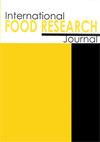Development of functional nougat without diabetic effects in vivo
IF 1
4区 农林科学
Q4 FOOD SCIENCE & TECHNOLOGY
引用次数: 0
Abstract
Nougat is a confectionery foodstuff made of whipped egg white, sugar, honey, and nuts. In a traditional Italian nougat recipe, the mixture is flavoured with vanilla extract, and packed with toasted almonds. Traditional nougat is banned from the diets of diabetics due to high amount of sugar. In the present work, we aimed to develop innovative sugar-free nougat, and compare its textural and sensory properties with those of commercial nougat. Finally, we tested the residual hyperglycaemic effect in non-obese diabetic (NOD) mice, a model of type 1 diabetes. We developed a sugar-free nougat recipe by mixing xanthan gum, erythritol, and inulin with egg white and almonds using conventional industrial instruments. Technical analysis indicated that the structure, in terms of shear force, was comparable with that of traditional chewy nougat. Sensory analysis indicated that flavour and sweetness were preserved, whereas cohesiveness and fracturability changed significantly. Interestingly, the innovative food composition positively influenced two other texture parameters; solubility and adhesiveness. In vivo experiments showed that the number of mice in the group that was fed with experimental nougat that did not develop diabetes was significantly higher than that in the group fed with commercial nougat (66.6% vs. 33.0%; p < 0.05), and not different from that in the group fed without nougat (72.7%; p = 0.37). In conclusion, we produced, on a pilot scale, innovative sugar-free nougat with improved texture and similar sensory properties, in comparison with the traditional product. In vivo, the experimental nougat did not increase the diabetes incidence significantly.开发体内无糖尿病影响的功能性牛轧糖
牛轧糖是一种由打发的蛋白、糖、蜂蜜和坚果制成的糖果食品。在传统的意大利牛轧糖配方中,混合物会加入香草精和烤杏仁。传统牛轧糖因含糖量高而被糖尿病患者禁止食用。在本研究中,我们旨在开发创新的无糖牛轧糖,并将其质地和感官特性与商业牛轧糖进行比较。最后,我们还在非肥胖糖尿病(NOD)小鼠(一种 1 型糖尿病模型)身上测试了其残留的高血糖效应。我们使用传统的工业仪器,将黄原胶、赤藓糖醇和菊粉与蛋白和杏仁混合,开发出一种无糖牛轧糖配方。技术分析表明,就剪切力而言,牛轧糖的结构与传统的咀嚼牛轧糖相当。感官分析表明,风味和甜味得到了保留,而内聚力和可碎性则发生了显著变化。有趣的是,创新食品成分还对其他两个质地参数产生了积极影响:可溶性和粘合性。体内实验表明,喂食实验牛轧糖的组别中,未患糖尿病的小鼠数量明显高于喂食商业牛轧糖的组别(66.6% vs. 33.0%;p < 0.05),与未喂食牛轧糖的组别(72.7%;p = 0.37)没有差异。总之,与传统产品相比,我们试制的创新型无糖牛轧糖口感更好,感官特性相似。在体内,实验性牛轧糖没有明显增加糖尿病的发病率。
本文章由计算机程序翻译,如有差异,请以英文原文为准。
求助全文
约1分钟内获得全文
求助全文
来源期刊

international food research journal
Agricultural and Biological Sciences-Food Science
CiteScore
1.40
自引率
0.00%
发文量
75
期刊介绍:
The International Food Research Journal (IFRJ) publishes papers in English, six (6) issues a year with the coverage of:
Food Science and Technology
Nutrition and Dietetics
Agriculture, multidisciplinary
Chemistry, multidisciplinary
The scope of the Journal includes:
Food Science, Food Technology and Food Biotechnology
Product Development and Sensory Evaluation
Food Habits, Nutrition, and Health
Food Safety and Quality
Food Chemistry, Food Microbiology, Food Analysis and Testing
Food Engineering
Food Packaging
Food Waste Management
Food Entrepreneur
Food Regulatory
Post-Harvest Food Management
Food Supply Chain Management
Halal Food and Management
 求助内容:
求助内容: 应助结果提醒方式:
应助结果提醒方式:


